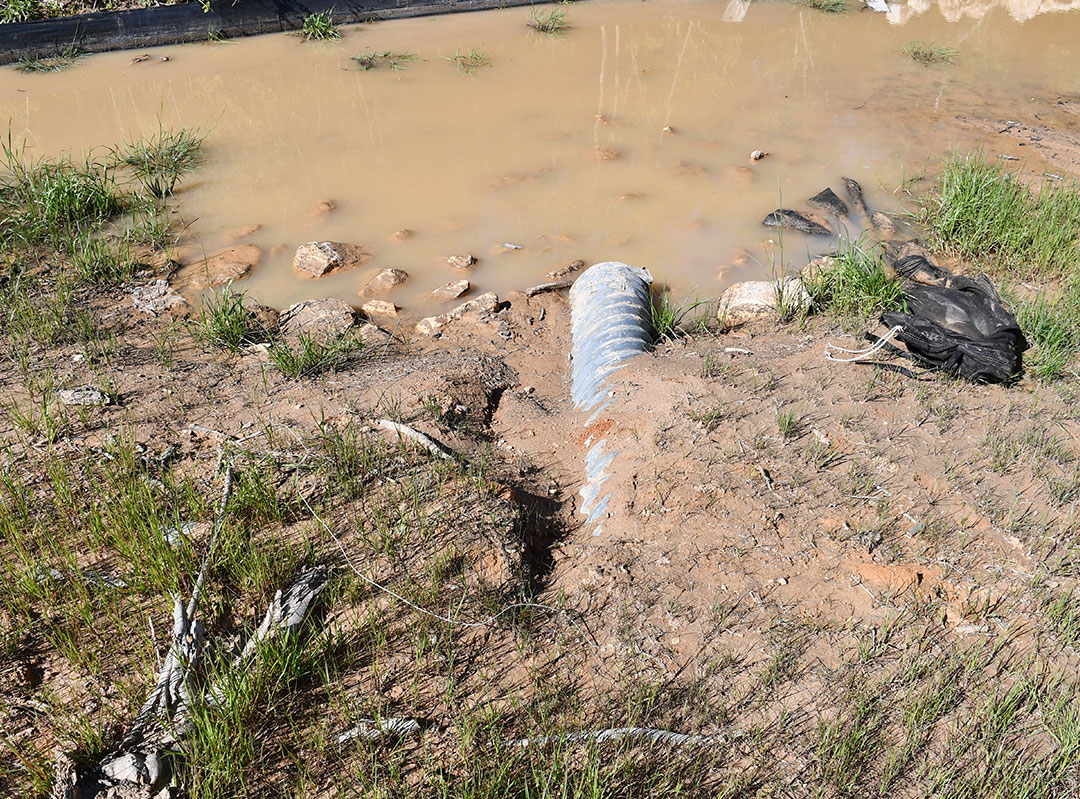
Properly stabilized basins and embankments support infrastructure longevity and mitigate the potential hazards associated with soil erosion. When executed correctly, basin stabilisation minimizes repairs, ensures environmental compliance, and maintains the integrity of wind farm and solar farm assets.
The Challenges of Destabilized Embankments and Culverts
Destabilized embankments and culverts present a range of challenges, especially for ground crews managing renewable energy sites. Erosion and soil displacement can damage critical infrastructure, compromising project performance and resulting in:
- Elevated Maintenance Costs: Continuous erosion requires regular interventions to maintain the site’s stability, resulting in higher project expenses.
- Environmental Damage: Soil displacement and sedimentation lead to long-term environmental issues, complicating compliance with environmental regulations, and risking penalties.
- Structural Instability: Compromised embankments and culverts affect the overall integrity of wind and solar farm sites, creating a higher likelihood of structural failure.
Addressing the challenges associated with destabilised embankments of ponds, dams and basins during the construction phase with appropriate stabilization methods is necessary to safeguard site infrastructure and optimize long-term performance.
AggreBind’s Role in Basin Stabilization and Erosion Control

Benefits of AggreBind for Basin Stabilization Include:
- Water Resistance: The hydrophobic qualities prevent water from entering the treated soil, reducing erosion and destabilization risks.
- Environmental Compliance: As a non-toxic, non-leaching and non-hazardous solution, AggreBind meets environmental and sustainability standards without compromising soil integrity, and without altering the soil’s pH.
- Increased Load-Bearing Capacity: The strengthened soil foundation supports heavy equipment and infrastructure, enhancing site stability.
Key Advantages for Renewable Energy Projects
- Water-Resistant Basin Stabilization for Longevity
The long-string cross-linking copolymer structure in AggreBind provides exceptional water resistance, which is critical for protecting ponds, basins and embankments from erosion caused by rain or flooding. A treated and surface-sealed area significantly reduces the risk of damage from water penetration, safeguarding site durability. The hydrophobic barrier ensures that water does not compromise the soil structure, enhancing the stability of wind farm and solar farm foundations.
- Environmentally Friendly Soil Stabilizer
The AggreBind solution aligns with sustainable construction practices and environmental compliance requirements. It’s non-toxic, non-hazardous and non-leaching formula makes it suitable for use in environmentally sensitive areas. In addition, the ability to encapsulate waste materials and even hazardous waste material, including construction by-products, aids in circularity efforts and supports renewable energy project goals for environmentally friendly site preparation.
- Structural Enhancement of Culverts and Embankments
By increasing the load-bearing capacity of soil around culverts and embankments, AggreBind effectively prevents structural issues such as washouts, water seepage, and general erosion. The result is stronger culverts and embankments that resist environmental and mechanical stresses. Improved structural integrity translates to fewer maintenance needs and less risk of infrastructure failure, contributing to efficient operations and project success.
- Cost-Effective Construction and Project Efficiency

The ability to utilize on-site materials eliminates the need for imported aggregates, leading to substantial savings in material costs and transportation. With quicker application and curing times, construction projects experience reduced equipment downtime and accelerated project timelines. For wind and solar farms, this translates to cost-effective, rapid site preparation that supports project efficiency and a lower overall cost of ownership.
- Sustainable and Durable Renewables Project Infrastructure
Wind and solar farm sites benefit from improved stability and reduced erosion, resulting in longer-lasting infrastructure with less need for ongoing maintenance. Properly stabilized basins protect against environmental and mechanical challenges, extending the life of critical assets on site.
The Long-Term Impact of Basin Stabilization on Wind and Solar Projects
Proper basin stabilization using AggreBind science plays a crucial role in the success of wind and solar farm construction. The increased load-bearing capacity and improved soil structure directly contribute to the reduced risk of embankment failure and culvert damage, which are critical to the stability of renewable energy infrastructure. Effective erosion control prevents costly sedimentation issues, minimizes the risk of water ingress, and ensures compliance with environmental regulations.
By implementing AggreBind as part of site preparation, project owners can achieve greater durability, reduce repair and maintenance requirements, and enhance the overall lifespan of wind and solar farm assets, resulting in both immediate and long-term cost savings, with sustainable site stability that supports the efficient operation of renewable energy projects. Utilizing AggreBind for basin stabilization not only aligns with sustainability goals but also optimizes construction efficiency, providing a practical solution to the challenges faced by renewable energy construction teams.
